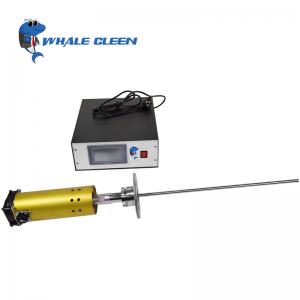

Add to Cart
220KHZ 2000W Sonicator Vibration Ultrasonic Cleaning Titanium Alloy Vibration Rods Diameter 10mm
1. Key technology information:
The ultrasonic vibrating rod is mainly composed of an ultrasonic transducer, an ultrasonic horn, an ultrasonic tool head and an ultrasonic drive power supply. Compared with the traditional ultrasonic vibration plate, it has the characteristics of wider application range and longer service life. In industrial applications, the use of ultrasonic vibrating rods for dispersion, extraction, cleaning, chemical reactions, water treatment, etc., it is a very mature and widely used technology. Extremely portable and easy to use.
2. Performance characteristics:
1. Suitable for various high-power industrial-grade liquid
treatments, such as homogenization, emulsification, dispersion,
depolymerization and wet grinding (particle size reduction), cell
disruption and disintegration, extraction, degassing, and
sonochemical processes;
2. Heavy load 24 hours continuous work, industrial design, external
PLC remote control, automatic frequency search and matching;
| Model# | Ultrasonic Frequency | Rod Material | Ultrasound Output | Diameter |
| LanJ-R7 | 20KHZ | Titanium Alloy | 300W | 10mm |
| LanJ-R7 | 20KHZ | Titanium Alloy | 600W | 10mm |
| LanJ-R7 | 20KHZ | Titanium Alloy | 900W | 10mm |
| LanJ-R7 | 20KHZ | Titanium Alloy | 1500W | 10mm |
| LanJ-R7 | 20KHZ | Titanium Alloy | 2000W | 10mm |
3. Market application:
1). Medicine extraction: refers to the ultrasonic pulverization (breaking) of Chinese medicine cells to achieve high-efficiency
extraction of useful substances. Compared with conventional extraction technology, ultrasonic assisted extraction is fast, inexpensive, efficient, safe, low in cost, and widely applicable.
2). Biodiesel production: The use of ultrasonic emulsification to produce a biomass oil-diesel mixed emulsion is actually to
disperse the bio-oil liquid beads into another immiscible diesel liquid. Compared with other technologies, the prepared droplets can be dispersed finely and narrowly distributed, high efficiency, good dispersion effect, and can increase the stability of the emulsion.
3). Ultrasonic sea life prevention: It is based on the cavitation effect of ultrasound. When the tiny
bubble nucleus in the liquid is activated under the action of ultrasound, it
manifests as a series of dynamic processes such as bubble
oscillation, growth, contraction and collapse. The bubbles in the
liquid generate over several hundred atmospheres and high
temperatures of thousands of degrees Celsius at the moment of
bursting,which can quickly peel off the attachment of sea creatures
and crush the epidermal cells of sea creatures, thereby achieving
the purpose of preventing sea creatures.
4). Ultrasonic catalysis: The application of ultrasound to the catalytic reaction process can
simulate the high temperature and high pressure reaction in the reactor on a
microscopic scale, providing a very special physical and chemical
environment for catalytic reactions that are difficult or
impossible to achieve under normal conditions. The catalytic
reaction can be carried out in a milder environment. It can further
increase the reaction speed, shorten the reaction time, and
increase the yield of the target product. The main applications
include catalysis on metal surfaces, phase transfer catalyzed
reactions, and enzyme catalyzed reactions.
5). Sewage treatment: In the process of sewage treatment, ultrasonic cavitation has a strong ability to degrade organic matter, and the degradation rate is very fast, which provides the possibility to degrade harmful organic matter in water, so as to achieve the purpose of ultrasonic sewage treatment.
6). Ultrasonic dispersion: refers to the process of dispersing and de-agglomerating particles
in the liquid through the "cavitation" effect of ultrasonic waves
in the liquid using liquid as a medium. Ultrasonic dispersion can
be divided into emulsion dispersion (liquid-liquid dispersion) and
suspension dispersion (solid-liquid dispersion), and has been
applied in many fields. The application of ultrasonic for the
dispersion of suspensions includes the dispersion of titanium oxide
in water or solvents in the coating industry, the dispersion of
dyes in molten paraffin wax; the dispersion of drug particles in
the pharmaceutical industry, and the powder emulsion in the food
industry Disperse etc.
4. Our Production Site
